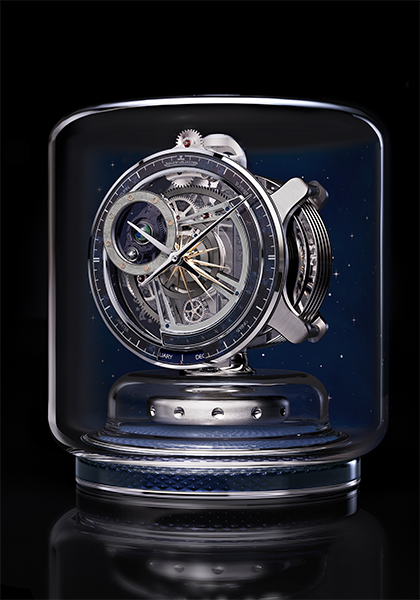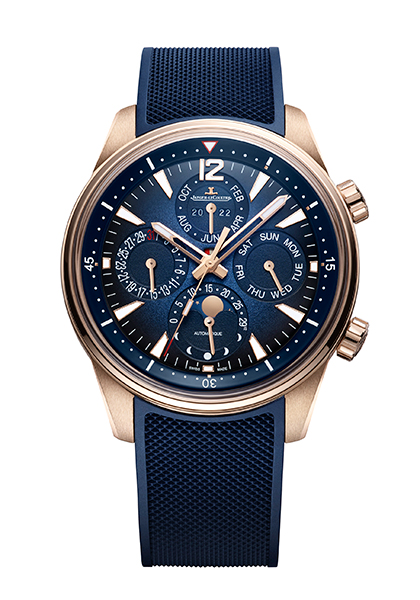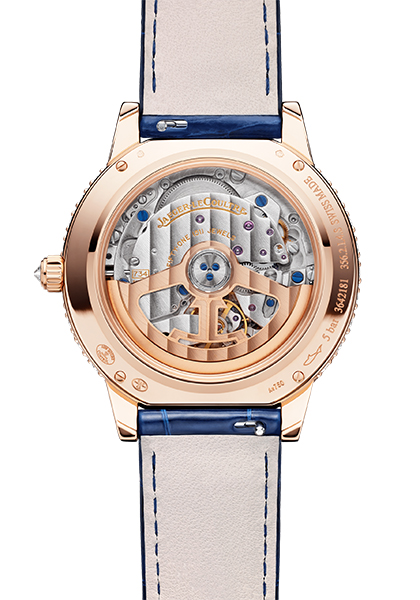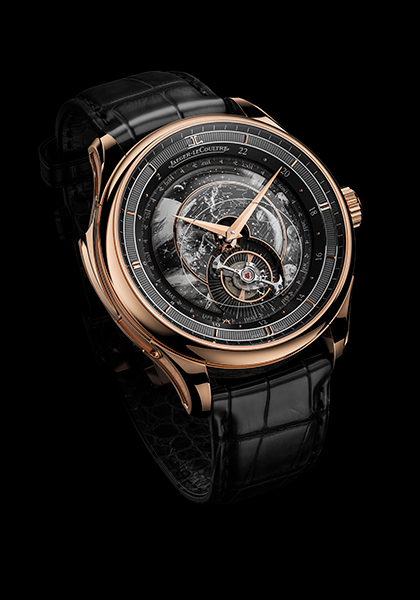You might think that following Watches And Wonders 2021, when Jaeger-LeCoultre launched what was arguably the most impressive and memorable complicated timepiece of the salon, that they would steer the ship in a completely different direction this year. You would be wrong. The Reverso Hybris Mechanica Cal. 185 Quadriptyque clearly remains a reigning masterpiece of astronomical horology, befitting of the anniversary celebrations of the most iconic wristwatch of Jaeger-LeCoultre. This year, the astronomical theme spreads to the rest of the Jaeger-LeCoultre collections, from the Atmos to the Rendez-Vous.
The Atmos clock is famed for its ability to run on air — a reputation that is not exactly 100 per cent accurate, but close enough. The Atmos actually runs on fluctuations of temperature and pressure, thanks to a capsule of ethyl chloride, an extremely volatile compound that is extremely sensitive to variations in temperature and pressure. Even the tiniest of atmospheric (hence the name of the clock) changes can cause the ethyl chloride to vaporise (therefore expanding) or condense (contracting), and it is this motion that winds the clock mainspring. A temperature variation of just one degree Celsius is enough to give the Atmos an additional 48 hours of wind.

A new Atmos movement, the Cal. 590, animates the Atmos Tellerium, which mechanically replicates the celestial interactions between the Earth, Moon and Sun. A fully three-dimensional spherical model of the Moon orbits a three-dimensional rotating spherical model of the Earth, each of them encased in sapphire-crystal bubbles that are smoked on one side and clear on the other, to simulate the effect of the Sun’s light on these two cosmic bodies. The Sun itself is represented by rays of rose gold that emanate from the centre of the clock dial. The months are indicated through an aperture at the 6 o’clock position, while the position of the Earth around the periphery of the dial indicates the season in the Northern Hemisphere. By far the most complicated Atmos ever made, Atmos Tellerium is finely decorated with laser engravings of the zodiac signs and hand-painted representations of the constellations.
The Jaeger-LeCoultre Polaris, an icon of watchmaking from the late 20th century, was revived by La Grande Maison in 2018, delighting longtime as well as new aficionados of the brand. Its iconic codes, including the large, easy-to-read hour numerals and trapezoidal markers, were brought back and updated to appeal to contemporary tastes whilst still maintaining the overall vintage attraction. This year, the Polaris receives a classic high complication in the form of a perpetual calendar. The perpetual calendar, distinct from the simple or annual calendar, is elevated by its ability to distinguish between the different lengths of the months throughout the year, being fitted with a special cam that allows it to skip directly from 30 (or 28) to 1 for the date display when necessary. Even during leap years, when February contains an additional day, the perpetual calendar is able to take this exception into account.

Of course, the Gregorian calendar system that we all take for granted is really an expression of the solar year — the time it takes for the Earth to complete an orbit around the Sun, with the months roughly commensurate to the lunar cycle (29.53 days). Although the perpetual calendar is a constant reminder that our concept of time is deeply rooted in the cosmic dance taking place overhead, we are rarely conscious of this fact as we go about our daily lives. Incorporating the perpetual calendar within a sports watch collection like the Polaris is a strong statement that reinforces how our lives are intertwined with cosmic activity, even if we don’t necessarily think about it all the time.

On a more romantic note, the Rendez-Vous collection — nominally a feminine collection but suitable for anyone who appreciates watches with a stronger decorative touch — is now endowed with a new dial animation that replicates the experience of encountering by chance a shooting star across the night sky. With each movement of the wrist, the automatic winding mechanism replenishes the mainspring barrel with energy, but also winds a smaller secondary spring, which releases when it is at maximum tension, sending a shooting star on a trip around the dial.

In both new models of the Rendez-Vous, the shooting star is for the most part hidden behind other dial elements, but commences its journey across aventurine skies whenever it is released by its spring mechanism. As we all know, there are no truly random elements in mechanical watchmaking — just like its modern equivalent, computer coding, everything must be strictly programmed. To come up with a truly random animation, based solely on the movement of the wearer’s wrist, is a stroke of ingenuity. If the wearer wishes to launch the animation, he or she can simply wind the crown, without waiting for the secondary spring to be wound by wrist movement.

In order to create a higher level of verisimilitude, the shooting star is formed out of two dial layers. There is one disc in aventurine, with a cut-out in the shape of a shooting star, which rotates when the animation mechanism is released. Directly below this aventurine cut-out disc is a fixed lacquered disc with a gradient effect going from dark at the outer edges to light in the middle. This allows the cut-out, when traversing the dial, to give the appearance of a shooting star that emerges from the darkness, goes to full brightness, and then fades back into the night sky — like a real shooting star.
Finally, the Master Grande Tradition Grande Complication (a mainstay of the highest levels of watchmaking at Jaeger-LeCoultre since 2010) returns, resplendent in a range of artisanal crafts. Renamed the Master Hybris Artistica Cal. 945 in this version focusing on decorative techniques, the rare and subtle art of grisaille enamel is highlighted in two exceptional models — the Master Hybris Artistica Galaxia and Master Hybris Artistica Atomium.

Grisaille is a highly delicate enamel technique that involves the interplay of white and black (or sometimes extremely dark blue) enamel. The artist starts with a base layer of perfectly opaque black enamel, which is in itself already extremely rare, since a truly black enamel is only achievable with old stocks of enamel pigment powders. Layers of white enamel are then meticulously layered on and individually fired in order to create a skillfully shaded and blended composition in black and white (and grey).
The scene depicted on the dial of the Master Hybris Artistica Cal. 945 is one of cosmic wonder, with the planets painstakingly detailed in hand-painted enamel. Making one complete rotation around the dial every sidereal day is the iconic Jaeger-LeCoultre flying tourbillon, called the Cosmotourbillon in this astronomical display. As a little refresher, the sidereal day is distinct from the solar day in that the latter uses the sun as a reference point and the former uses the stars. The central dial portion is further decorated with a star map representing the constellations as seen over the home of Jaeger-LeCoultre, Le Sentier in the Vallée de Joux. In the Atomium model, the delicate lattice of interconnected nodes that we first saw in the Master Grande Tradition Grande Complication (2020) is back, evoking the profound link between the smallest and largest components of the material universe. Astronomer Carl Sagan was fond of highlighting this link, saying that every atom in our living bodies came from the stars; that we are essentially stardust. In the Jaeger-LeCoultre Master Hybris Artistica Cal. 945, the same message is expressed, in a celebration of science and art.




